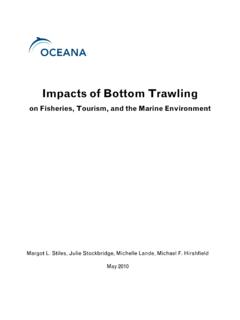Transcription of The world lobster market - Food and Agriculture Organization
1 GLOBEFISH RESEARCH PROGRAMME. The world lobster market Volume 123. FAO GLOBEFISH RESEARCH PROGRAMME VOL. 123. The world lobster market by Graciela Pereira Helga Josupeit FAO Consultants Products, Trade and Marketing Branch Fisheries and Aquaculture Policy and Resources Division Rome, Italy FOOD AND Agriculture Organization OF THE UNITED NATIONS. Rome, 2017. The designations employed and the presentation of material in this information product do not imply the expression of any opinion whatsoever on the part of the Food and Agriculture Organization of the United Nations (FAO) concerning the legal or development status of any country, territory, city or area or of its authorities, or concerning the delimitation of its frontiers or boundaries.
2 The mention of specific companies or products of manufacturers, whether or not these have been patented, does not imply that these have been endorsed or recommended by FAO in preference to others of a similar nature that are not mentioned. The views expressed in this information product are those of the author(s) and do not necessarily reflect the views or policies of FAO. ISBN 978-92-5-109631-4. FAO, 2017. FAO encourages the use, reproduction and dissemination of material in this information product. Except where otherwise indicated, material may be copied, downloaded and printed for private study, research and teaching purposes, or for use in non-commercial products or services, provided that appropriate acknowledgement of FAO as the source and copyright holder is given and that FAO's endorsement of users' views, products or services is not implied in any way.
3 All requests for translation and adaptation rights, and for resale and other commercial use rights should be made via or addressed to FAO information products are available on the FAO website ( ) and can be purchased through FAO. January 2017. The world lobster market , by Graciela Pereira and Helga Josupeit, FAO Consultants. Globefish Research Programme Volume 123. Rome, Italy. ABSTRACT. This is a report on the size of the market for Caribbean spiny lobster (Panulirus argus), the biggest market players (traders, retailers, restaurant chains) and their relationship to producers in Central America in order to contentualize the market for Caribbean spiny lobster .
4 General aspects of the lobster market are discussed in detail, including all types of lobster species and harvesting methods used in the geographic area under analysis. Layout: Gloria Loriente Cover photograph: Courtesy of Graciela Pereira iii TABLE OF CONTENTS. 1. INTRODUCTION 1 2. LOBSTERS AND lobster PRODUCTION 2 CARIBBEAN SPINY lobster 6 Honduras and Nicaragua 7 lobster MANAGEMENT SYSTEMS IN THE CARIBBEAN 8 Honduras and Nicaragua 9 3. PRODUCT FORMS AND VALUE ADDITION FOR ALL TYPES OF. lobster 11 4. TRADE OF ALL lobster SPECIES 13 5.
5 MAIN MARKETS FOR ALL LOBSTERS 15 NORTH AMERICA 15 United States of America 15 Canada 18 CHINA 19 China mainland 19 China, Hong Kong (SAR) 20 EUROPE 20 France 21 Spain 23 Italy 24 6. EXPORTS 26 NICARAGUA 26 HONDURAS 27 7. CONCLUSION 28 8. REFERENCES 31 iv FIGURES. 1. lobster prices, United States of America, France and China, 1990 2014. (unit value of imports) 14. 2. Prices of lobster tails imported from Nicaragua and Honduras to the United States of America, July 2011 July 2015 17. 3. Prices of European lobster imported from Ireland to Europe, October 2010 October 2015 22.
6 4. Unit value of lobster (US$/tonne), 2004 2014, calculated based on the Global Trade Information System (GTIS) 27. TABLES. 1. Total world lobster production by country of origin (tonnes) 3. 2. world lobster landings by species, 1980, 1990, 2000, 2010, 2012 and 2013 (tonnes) 5. 3. Total Caribbean spiny lobster production, 1980, 1990, 2000, 2010, 2012 and 2013 (tonnes) 7. 4. world : Quantity of lobster imports, 2009 2014 (tonnes) 13. 5. world lobster imports, 2009 2014 (US$ million) 13. 6. United States of America: Quantity of lobster imports, 2009 2014 (tonnes) 16.
7 7. Value of US imports of lobster , 2009 2014 (US$ million) 18. 8. China: Quantities of lobster imports, 2009 2014 (tonnes) 19. 9. China, Hong Kong SAR: Quantity of lobster imports, 2009 014 (tonnes) 20. 10. France: Quantities of lobster imports, 2009 2014 (tonnes) 21. 11. France: Value of lobster imports, 2009 2014 (US$ million) 22. 12. Spain: Quantities of lobster imports, 2009 2014 (tonnes) 23. 13. Spain: Value of lobster imports, 2009 2014 (US$ million) 24. 14. Italy: Quantities of lobster imports, 2009 2014 (tonnes) 25.
8 15. Nicaragua: Quantity of lobster exports, 2007 2014 (tonnes) 26. 16. Honduras: Quantity of lobster exports (tonnes) 27. 17. world : Quantity of lobster imports, 2007 2012 (tonnes) 29. 18. world : Value of lobster imports, 2007 2012 (US$ million) 30. v 1. INTRODUCTION. This is a report on the size of the market for Caribbean spiny lobster (Panulirus argus), the biggest market players (traders, retailers, restaurant chains) and their relationship to producers in Central America. In order to put the market for Caribbean spiny lobster into the correct context, general aspects of the lobster market are discussed in detail, including all types of lobster species.
9 It will also discuss the harvesting methods used in the geographic area under analysis. This report will serve as a basis for a feasibility study on market -based incentive schemes for selling product produced through decent employment, which would exclude, for example, the use of scuba diving as practised in in Honduras and Nicaragua. The main purpose of the market -based incentive scheme will be to reduce the market demand to zero for lobster harvested by scuba diving. In the preparation for this study, some of the main importers of lobster in Florida were interviewed as well as supermarket clients and restaurant owners in order to perceive the sensitivity of consumers to lobster harvest and the risks involved for scuba divers.
10 1. 2. LOBSTERS AND lobster PRODUCTION. The category lobster comprises four main commercial species: European lobster (Homarus gammarus), American lobster (Homarus americanus), rock lobster (Jasus spp.) and tropical or spiny lobster (Panulirus spp. or Palinurus spp.). Since lobster is a highly prized delicacy throughout the world , there are many ongoing technical advances in all the major lobster producing countries to ensure that stocks will remain sustainable for future generations. These include the development of hatchery techniques to enhance fisheries, which have been successful for the Homarus species and which are in the trial stages for rock lobster .












